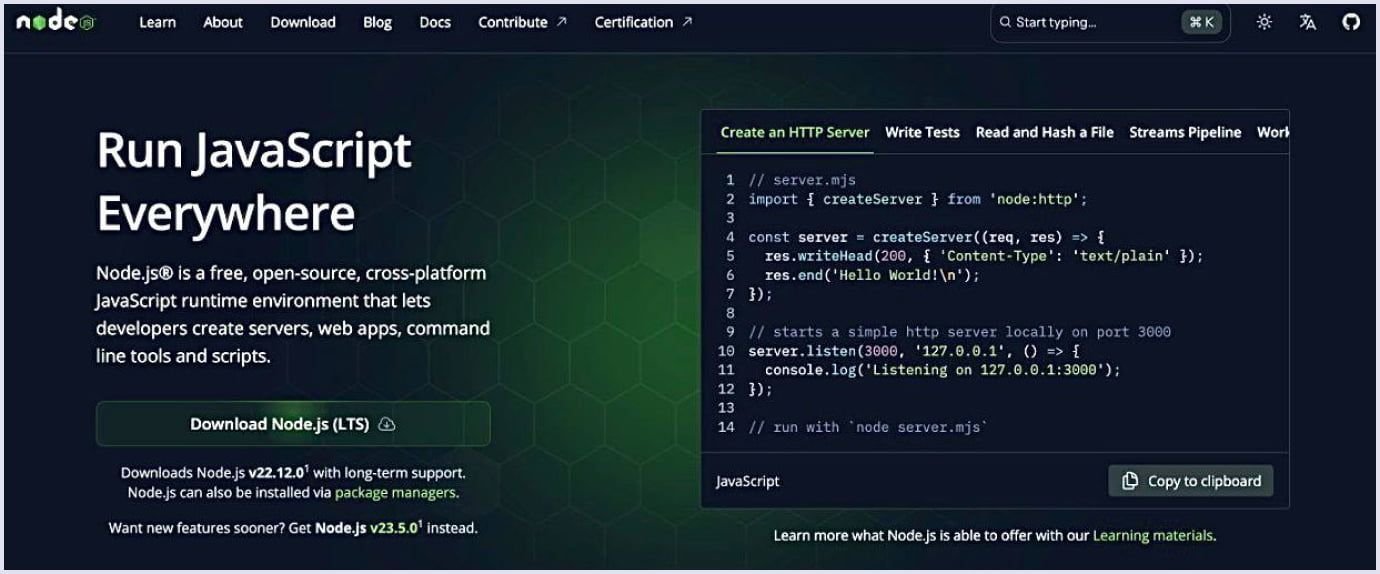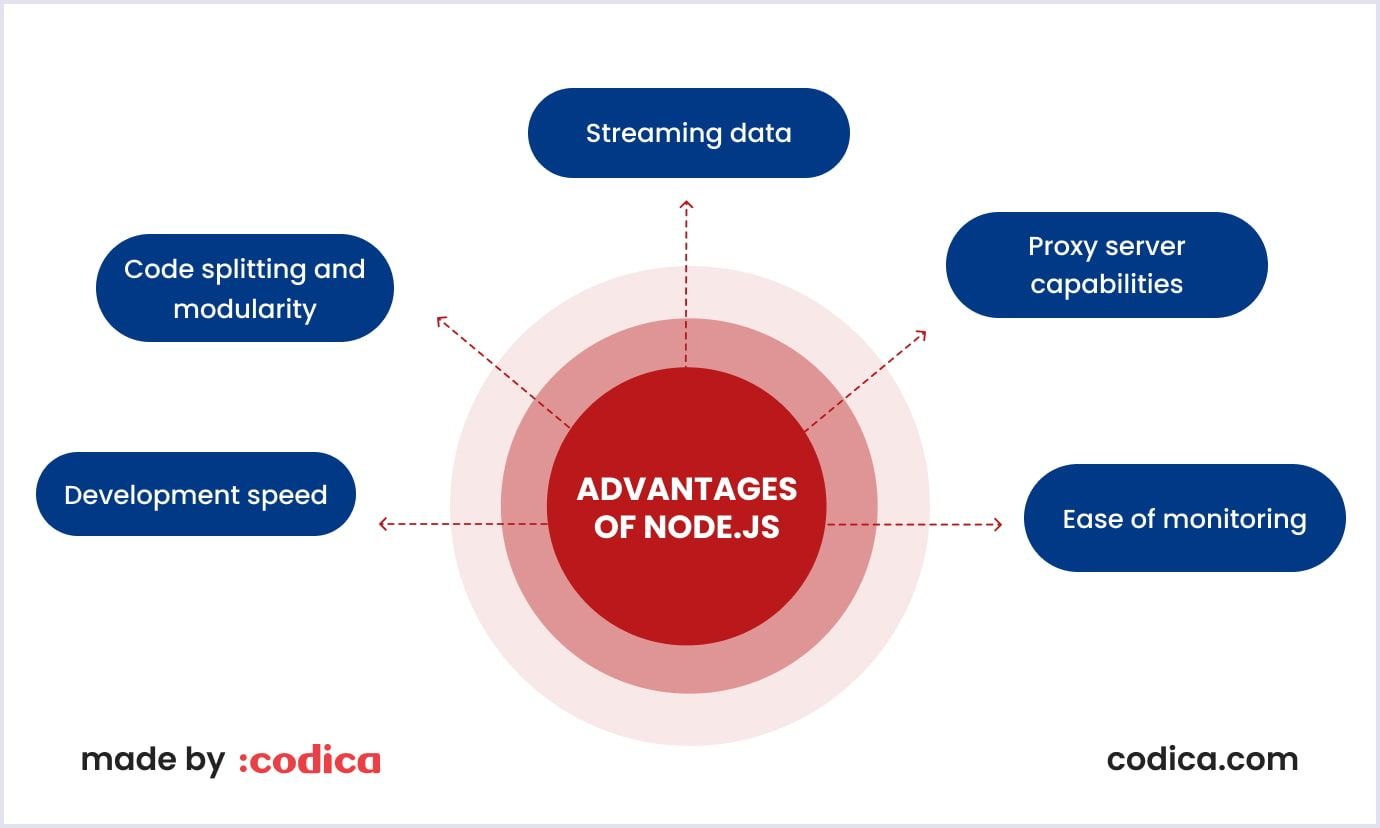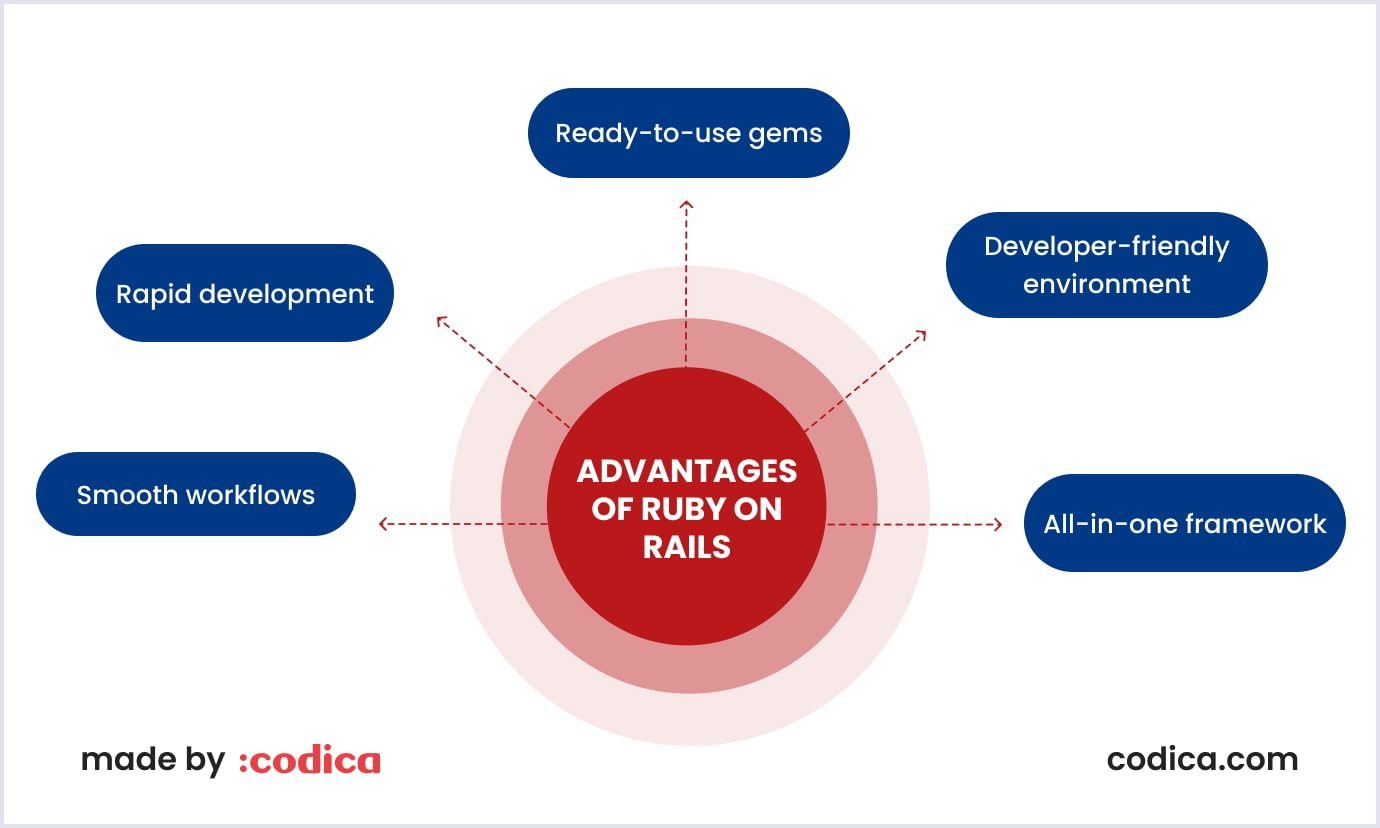Choosing the right backend technology for your application is one of the most important steps you can take and can determine the future of your project. Among all the backend technologies, Node.js and Ruby on Rails are two strong contenders; each has certain advantages.
Node.js is a high-performance JavaScript runtime engine for building fast and scalable server-side applications. According to Forbes, Node.js is not a choice in 2025 - but an investment in your product's success. The more interesting issue is Ruby on Rails, which represents the grown form of a web framework based on a Ruby programming language. Ruby on Rails is also trending in 2025 and popular with start-ups and businesses that want to move fast and ensure reliability.
At Codica, we have worked extensively with both technologies and have delivered several successful projects using both Node.js and Ruby on Rails. Understanding the differences between those two will help you choose the perfect fit for your project's unique needs.
Understanding Node.js
First, Node.js is an out-of-browser JavaScript runtime environment that allows you to write server-side code for web pages, applications, and command-line programs.

Source: Node.js
It is powered by Chrome's V8, known for its fast and non-blocking event-driven architecture, making it ideal for scalable, high-performance applications. Node.js works seamlessly on platforms such as Linux, MacOS, and Windows, allowing developers to handle files, databases, and networks on the server side using the same JavaScript language they use on the client side.
Node.js remains the darling for real-time application development, RESTful APIs and other modern web applications in 2025. Its latest LTS release, Node.js 22.x, boasts advanced module handling with increased performance.
With its extensive ecosystem of packages available through the node package manager (npm) and its capability to efficiently handle highly concurrent tasks, Node.js remains a top choice for developers worldwide, supported by an active community and ongoing innovations..
Understanding Ruby on Rails
Ruby on Rails, commonly known as Rails, is a powerful open-source web application framework written in the Ruby programming language. Ruby 3.2 is the current version with performance and concurrency enhancements, and with better developer productivity to make Rails even more robust for modern web development.

Source: Ruby on Rails
Since its release in 2004, it has won the admiration of developers for its speed, simplicity, and ability to make web development truly efficient.
Built on the philosophy of "developer happiness" coined by its creator, David Heinemeier Hansson, Rails places great emphasis on reducing repetitive work and letting developers focus on creating elegant, high-performance web applications.
Based on MVC, Rails can handle everything from business logic to data processing. Major databases supported include MySQL, PostgreSQL and SQLite. The syntax is clean, intuitive, and readable.
Whether it is a small startup project or a highly scalable enterprise platform, Rails gives developers the power to move faster without compromising on quality, making it one of the staples of modern web development.
Node.js vs. Ruby on Rails: peculiarities
The core strengths of Node.js and Ruby on Rails: the real-time scalability of Node.js and the simplicity of Rails.
Node.js: more than just scalability
Node.js has gained prominence for its ability to support real-time and event-driven applications, including live chat, collaboration tools, and streaming platforms. Due to its non-blocking I/O model, developers can handle thousands of concurrent connections without overloading server resources and, hence, they are considered the first choice for modern user-intensive applications.
Recently, the most favorite use of Node.js has become the creation of microservices: large systems can be divided into smaller pieces that are independently deployable components.
Besides that, it provides seamless integration with serverless environments like AWS Lambda and Google Cloud Functions, allowing developers to construct scalable and cost-effective solutions. Besides that, an enormous npm ecosystem with thousands of reusable modules makes it a tool that massively speeds up development while reducing its complexity.
Ruby on Rails: simplicity with power
Ruby on Rails is all about quickly developing web applications, even without compromising on the quality of these applications.
Some inbuilt integrations, like Active Record for managing databases, Action Mailer for handling emails, and Action Cable supporting WebSockets, will limit the developer from using any third-party integration with Rails. It is a framework that allows the developer to build functionality and not reinvent the wheel.
Rails also pays close attention to clean, maintainable code. It enforces conventions that make projects easier to scale and work on as teams grow. Strong testing tools within the framework ensure applications can be reliable from the start, saving time and headaches down the line.
In addition, the strong Rails community means there is a wealth of resources, plugins, and gems to solve complex development challenges. Whether you are building a startup prototype or scaling an enterprise application, Rails provides the flexibility and power to grow with your needs.
Read also: SaaS Product Development: Why Choose Ruby on Rails Framework?
Node.js vs. Ruby on Rails: a showdown of technology titans
Let's look at the table before moving on to a detailed review of each of the comparison components presented. This shows the criteria that can be used to describe each technology.
| Criteria | Node.js | Ruby on Rails |
| Definition | Server-side JavaScript runtime with non-blocking, event-driven architecture | Web framework in Ruby focusing on convention over configuration |
| Scalability | Excellent scalability, ideal for real-time applications | Scalable but often requires additional optimization |
| Performance | High performance, particularly for asynchronous and real-time applications | Reliable performance, best suited for traditional web applications |
| Community | Large and growing community with an extensive npm ecosystem | Established and loyal community with a rich library of gems and plugins |
| Flexibility | Highly flexible, adaptable to various project requirements | Structured and consistent but less flexible |
| Cross-platform compatibility | Runs seamlessly on Windows, macOS, and Unix-based systems | Best suited for Unix-based systems, needs configuration for Windows |
Now, we proceed directly to the analysis of each aspect separately.
Scalability
Node.js is fit for scalability because of its event-driven and non-blocking nature. That's why it suits real-time, high-load apps with thousands of concurrent connections so well, be it live chats, collaboration tools, or video streaming services. Efficient handling of numerous concurrent connections allows it to respond smoothly under the heavy load.
Ruby on Rails easily scales, though it usually requires more effort to achieve the same level of performance as in Node.js. The structured approach of Ruby on Rails does allow consistency, which is great for predictable workflows, but that may be a thing to optimize when projects are very dynamic or large.
Performance
Node.js is particularly well-suited for real-time and data-driven applications. This feature of non-blocking execution of operations makes Node.js great for applications in financial analytics, IoT systems, and online gaming.
Ruby on Rails is very consistent in applications where speed is not an issue. This makes it more applicable when clean and maintainable web applications need to be built without much stress on asynchronous processing.
Community
Both technologies have very active and supportive communities. Node.js has an extended library through npm, making it a preferred choice for rapid prototyping, scalable solutions for almost any development need. Ruby on Rails has had more time to build its community, and the resources, gems, and best practices available ensure that complex web development tasks are well supported.
Flexibility
Node.js is incredibly flexible, making it suitable for everything from serverless applications to microservices architecture. It's dynamic, and the latest technologies can be integrated into a developer's work with ease.
Ruby on Rails, while less flexible, excels at providing a well-defined framework. Its convention-over-configuration approach ensures structured development and clean code, making it an excellent choice for teams looking for consistency and maintainability.
Cross-platform compatibility
Node.js is designed to run seamlessly on multiple operating systems, including Windows, macOS, and Unix-based platforms, making it versatile for diverse environments.
Ruby on Rails, while primarily optimized for Unix-based systems like Linux and macOS, can also be deployed on Windows with additional configurations. This flexibility ensures its adaptability across various platforms, though it performs best in Unix-based environments.
Both technologies bring distinct advantages to the table, and choosing the right one depends on the specific requirements and goals of your project.
Node.js: advantages and challenges
Node.js has completely changed backend development by making it faster, more scalable and flexible. While it has many advantages that make development easier and faster, there are also challenges that developers must overcome to use it fully.
Let's look at the main advantages and how to overcome the common challenges.
Advantages of Node.js

Node.js has a lot of advantages in modern development:
- Development speed. Node.js runs on Google V8 for lightning-fast execution. Its asynchronous nature allows tasks to be completed much faster, not only for developers but for businesses in general.
- Code splitting and modularity. The npm ecosystem seamlessly distributes tasks across teams. Integrating millions of out-of-the-box packages speeds up the development process phenomenally.
- Streaming data. Node.js streams data with unparalleled efficiency, making it the first choice for real-time applications, from video platforms to collaboration tools.
- Proxy server capabilities. Node.js can easily act as a lightweight proxy server to route client communications to an external service efficiently and without complication.
- Ease of monitoring. Powerful tools such as PM2 make it relatively easy to monitor and manage high-traffic applications, allowing developers to focus on feature development rather than troubleshooting.
Common challenges of Node.js and their solutions
Despite the great advantages of Node.js, it also introduces some challenges that a developer needs to keep under control:
- CPU-intensive activities. Node.js is not inherently optimized for CPU-intensive tasks such as image processing. This can, however, be worked around by using worker threads to parallelize tasks or using tools like Rust or Python for specific processing needs.
- Security vulnerabilities. One of the major concerns with Node.js is security, given the very dynamic nature of its npm ecosystem. Developers can secure their applications by running regular checks of dependencies with tools like Snyk, following best practices for securing APIs, and keeping packages updated.
Most of these challenges can be overcome through being proactive. Knowing what for which Node.js should be used and combining this with complementary technologies that can take the heavy lifting of CPU-intensive tasks will retain efficiency. Similarly, the adoption of strict security practices will keep applications robust and safe from vulnerabilities.

Ruby on Rails: advantages and challenges
Ruby on Rails has carved its niche among developers due to the ease with which it simplifies complex tasks and delivers results in a very powerful way. Known for efficiency and friendliness to developers, RoR is ideal for robust web application development. Like any framework, it too has its challenges. Let's break down why Ruby on Rails stands out and how to handle its challenges:
Advantages of Ruby on Rails
RoR remains a top choice for those who value both the art and science of custom web development. What makes Rails a go-to framework?

- Smooth workflows. RoR's convention-over-configuration approach eliminates unnecessary decisions with intelligent defaults. Developers focus on building features rather than configuring the basics, saving time and reducing errors.
- Rapid development. Whether it is a quick prototype or a full-blown application, RoR's libraries and built-in tools get your project up and running in record time, which is perfect for businesses that are racing against the clock.
- Ready-to-use gems. A huge library of gems makes it easy to implement complex features like user authentication or database management without reinventing the wheel.
- Developer-friendly environment. RoR has clean syntax and an organized structure that makes collaboration easy and keeps your codebase clean and tidy. In addition, its built-in testing features allow you to ensure that your application runs without bugs.
- All-in-one framework. RoR covers both the frontend and backend, making it easier for teams to work together and for new developers to join a project without a steep learning curve.
Challenges of Ruby on Rails and how to overcome them
Like with any other tool, RoR has its drawbacks, but such can be effectively handled if done in the right manner:
- Performance speed. RoR is not the fastest compared to other technologies such as Node.js. Developers can optimize code, use caching, and choose a hosting solution that's tailored to Rails applications. This can make a huge difference to how smoothly the application runs.
- Memory management. If memory isn't managed well, Rails can experience execution delays due to its garbage collector. This should be monitored using New Relic or Scout for memory usage, and there may be a need to prevent memory leaks through optimizations in the code. Sophisticated applications will certainly require more advanced approaches to memory management.
- Security risks. Like any framework, Rails is susceptible to security vulnerabilities such as SQL injection or cross-site scripting (XSS). Keeping your gems up to date, sanitising input, and using parameterized queries will go a long way to securing your application. Rails also comes with some security out of the box - use it.
Keep your code optimized, stay updated, and use the in-built tools that Rails provides to protect your app. If done correctly, these challenges are not going to stop you.
Use сases: Node.js and Ruby on Rails
Both Node.js and Ruby on Rails are disruptive tools within web development, each bringing unique strengths. In the hands of creative and forward-thinking developers, these technologies have proven their worth, from powering real-time applications to managing complex ecommerce platforms.
Let's discover what makes them so special and how companies around the world are using them.
Node.js use cases
Node.js is where developers go when speed, scalability, and realtime are required. It has become a darling of so many applications because of its versatility:
- Real-time applications. Live chat apps, Google Docs-like collaborative tools, and online gaming use Node.js as the backbone since immediate responses are crucial.
- Streaming data. In the case of live video platforms, music streaming, or real-time analytics, Node.js efficiently handles streamed data for fluent user experiences.
- Development tools. Most of the popular build tools or task runners are powered by Node.js, such as Webpack or Gulp, serving to make lives easier for developers in the JavaScript ecosystem.
- IoT solutions. Node.js, from smart home devices down to industrial sensors, allows device communication and data processing that make a system smarter using tools like Espruino.
- Microservices architecture. Node.js will let developers break down very complicated systems into smaller, manageable services that scale and maintain quite well.
- Command-line tools. It is ideal for automating repetitive tasks or even building CLI tools for giving more power and efficiency to developers.
Popular companies using Node.js
Global giants like Netflix, Uber, and PayPal use Node.js to manage a huge number of users and introduce real-time functionality. Even NASA adopted Node.js to cover mission-critical data after one incident that almost happened:
- Netflix. This company began using Node.js to deliver massive Internet streaming to over 182 million users. Netflix also wanted to expand its use of Node.js to content production.
- Uber. Because of its asynchronous primitives and simple single-threaded processing, Uber's core ride execution engine was originally developed in Node.js.
- PayPal. In replacing Java, PayPal decided to use JavaScript from the browser to the back end to build web applications.
- NASA. After an unfortunate accident in space, NASA decided to use Node.js to better protect its data and even prevent loss of life.
- LinkedIn. LinkedIn chose Node.js for its scalability and efficiency, and stopped using Ruby on Rails.
Ruby on Rails use cases
RoR is all about rapid development, cleanliness of code, and a focus on the delivery of quality applications. Its forte is in the development of robust, feature-rich platforms quickly and efficiently:
- Full-stack web applications. RoR seamlessly integrates the frontend and backend, making it ideal for building user-friendly web apps with complex business logic and database interactions.
- Content management systems. Be it a corporate blog site or an e-magazine, RoR makes it easier for developers and end-users alike in creating and managing content.
- Ecommerce sites. Shopify remains one of the best examples of what RoR is capable of accomplishing in the case of high load ecommerce portals, complete with product management, payment gateways, and analytics.
- Social networks. RoR does a good job managing complex relationships, which, alongside the dynamic content handling, makes RoR appropriate for creating scaled social platforms: Twitch or GitHub, for example.
- Rapid prototyping. With RoR's baked-in functionality and broad support via libraries and gems, RoR is the go-to rapid prototyping tool of choice among many startups to build test ideas fast and provide early feedback prior to full development.
Popular companies using Ruby on Rails
Companies like Airbnb, GitHub, and Shopify were built on top of Ruby on Rails. The scalability and adaptability when businesses grow has made it a trusted choice for startups and enterprises alike:
- Airbnb. This company has been using Ruby on Rails since its start. The framework plays a vital role in Airbnb's technology stack.
- GitHub. Its backend is Ruby on Rails, with over 200 million code repositories and 32 million monthly users.
- Shopify. It is an excellent example of a complex yet well-structured and user-friendly Ruby on Rails e-commerce platform that over 820,000 merchants use.
- Fiverr. This company also adopted Ruby on Rails at launch, which is still the technology that powers their online marketplace service.

Bottom line
So is Node.js better than Ruby on Rails? Well, first of all, that's not really the right question to ask. If you look at our analysis, you will see that they both have their pros and cons, different use cases, and strong communities that make them popular or not with developers. But at the end of the day, whether you should use them is up to you, based on the things we talked about in this article.
Ruby on Rails and Node.js may be slightly different, but in the grand scheme of things they actually have a lot in common. In terms of backend development, they're both very important, but they do different things. It's up to you to like one or the other, because they make great web applications.
Are you planning to bring in a cutting-edge tech stack for your forthcoming business project? With our custom software development services, the Codica team delivers robust and scalable solutions.
Feel free to contact us and view our portfolio!

